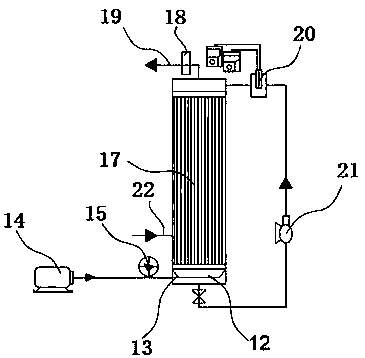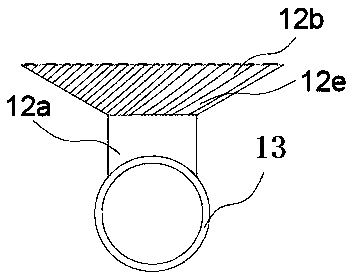Bacteria and algae collaborated method for efficient treatment of aquaculture sewage
A technology of bacteria and algae synergy and breeding sewage, which is applied in the direction of filtration treatment, sedimentation treatment, special treatment goals, etc., can solve the problems of affecting growth, poor stability of treatment effect, loss of algae cells, etc., to increase the generation of air bubbles and promote microalgae Effects of growth, prolongation of contact time
- Summary
- Abstract
- Description
- Claims
- Application Information
AI Technical Summary
Problems solved by technology
Method used
Image
Examples
Embodiment 1
[0026] Such as figure 1 As shown, the device for bacteria and algae synergistically efficient treatment of aquaculture sewage includes a composite bacteria aeration tank 3 and an air-lift columnar photobioreactor 4 . The water inlet of the compound bacteria aeration tank 3 is connected to the water outlet of the grille tank 2 through a water pipe, and the water outlet of the compound bacteria aeration tank 3 is connected to the water inlet of the air-lift columnar photobioreactor 4 through a water pipe; the air-lift columnar photobioreactor There are 3 devices 4, which are connected in series; the water outlet of the air-lift columnar photobioreactor 4 at the end is connected with the water inlet of the sedimentation tank 5 through a water pipe; the water outlet of the sedimentation tank 5 is connected with the ozone decolorization tank 6 through a water pipe The water inlet of the ozone decolorization pool 6 is connected with the water inlet of the water outlet pool 7; the wa...
Embodiment 2
[0031] Such as Figure 1~5 As shown, the method of cooperating with bacteria and algae to efficiently treat aquaculture sewage: livestock and poultry sewage flows from the raw water pool 1 into the grid pool 2, and the grid pool 2 performs preliminary purification on it to remove large suspended particles. Then it flows into the complex bacteria aeration tank 3, and the synergistic action of autotrophic ammonia oxidizing bacteria, autotrophic nitrifying bacteria and heterotrophic nitrifying bacteria converts ammonia nitrogen in livestock and poultry sewage into nitrate nitrogen. The treated sewage is passed into the air-lift columnar photobioreactor 4 from the water inlet 22, and the microalgae with the preservation number of CCTCC NO: M 2017461 is used to remove nitrogen and phosphorus and accumulate biomass. The airlift columnar photobioreactor 4 has a built-in membrane module 17 as a microalgae attachment material, and the bottom of the airlift columnar photobioreactor 4 is...
Embodiment 3
[0033]Biomass measurement: Measure the OD value of the microalgae liquid in Example 1 at 680nm, and count microalgae at the same time, count the microalgae less than 10 μm with a hemocytometer, and count the cell density with a 0.1mL phytoplankton counting frame for the algae greater than 10 μm (count at least 3 times). The OD value was plotted against the cell density to obtain the absorbance coefficient. Then use the formula (lg(m)=-1.0465ln(x)+4.255, where m is the biomass and x is the absorptivity) to convert the absorptivity into biomass. The biomass accumulation in the microalgae of Example 1 after 15 days of treatment was measured according to the above method.
[0034] Determination of crude protein content: the crude protein content in the microalgae in Example 1 was measured by micro Kjeldahl method after 15 days of treatment.
[0035] Determination of oil content: the content of oil in microalgae in Example 1 was measured by Sudan Black B staining method after 15 ...
PUM
| Property | Measurement | Unit |
|---|---|---|
| pore size | aaaaa | aaaaa |
| pore size | aaaaa | aaaaa |
Abstract
Description
Claims
Application Information
 Login to View More
Login to View More - Generate Ideas
- Intellectual Property
- Life Sciences
- Materials
- Tech Scout
- Unparalleled Data Quality
- Higher Quality Content
- 60% Fewer Hallucinations
Browse by: Latest US Patents, China's latest patents, Technical Efficacy Thesaurus, Application Domain, Technology Topic, Popular Technical Reports.
© 2025 PatSnap. All rights reserved.Legal|Privacy policy|Modern Slavery Act Transparency Statement|Sitemap|About US| Contact US: help@patsnap.com



